What is Data Mining?
Data mining refers to the process of using computed-assisted techniques and automation to sort and process large data sets to identify patterns and extract information useful for organizations. It is also known as knowledge discovery in databases that helps organizations transform raw data into useful business insights and practical knowledge.
However, this mining process relies heavily on the effectiveness of the data collection, warehousing, and processing. All the data mining tools and techniques enable organizations to make data-driven decisions and predict future trends.
It has become a key aspect for most organizations as it helps with data analytics. The data mining techniques involving data analysis mainly provide two outcomes which describe a data set and predict outcomes through machine learning.
The use of Artificial Intelligence and Machine Learning has become common in data mining as it enables automation which is important for enhancing the processing speed. Most organizations dealing with customers rely on it as it helps them learn about their customers, especially their behavior and patterns. Besides it also comes useful in modern cybersecurity as it identifies frauds and security issues.
How Does Data Mining Work?
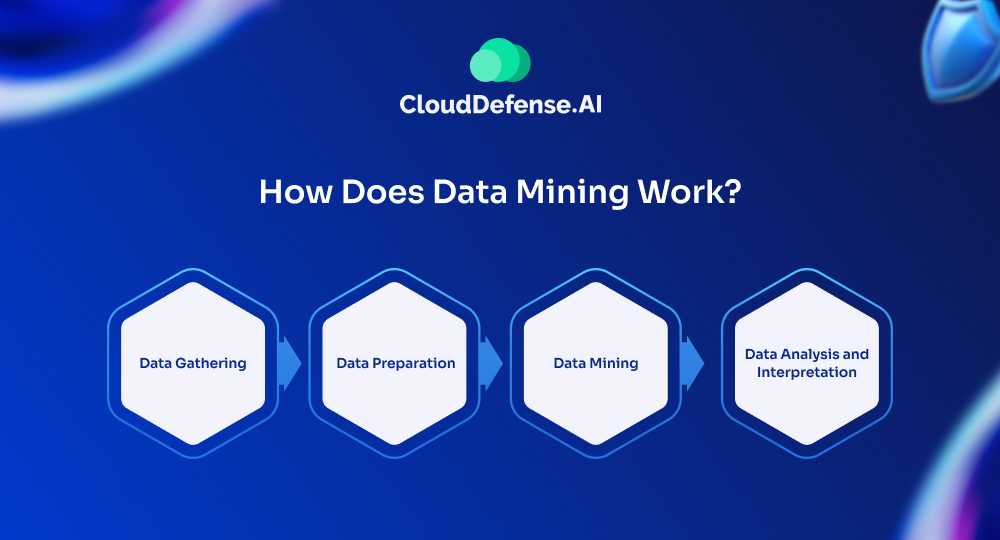
Data mining is one of those vital tasks of an organization that are mostly performed by data scientists and analytics professionals. However, data-savvy BIs and other workers also perform this mining based on their skill set.
This process mostly includes exploring, processing, and analyzing large data sets collected by organizations to extract useful patterns and trends. From performing marketing research and fraud detection to spam filtering, this is utilized by organizations on many occasions.
The stages of data mining might differ according to the requirement of an organization but the primary work is based on four stages:
Data Gathering
Data gathering is the first stage where all the relevant data is identified and collected in a data lake or warehouse on-site or cloud. This stage also involves gathering relevant information from various external sources for better insight.
Data Preparation
This stage involves business analysts, IT professionals, and management of the organization who work on the data. The data preparation process involves data profiling, exploration, and pre-processing along with data cleaning so that it is completely ready for mining and error-free.
Data Mining
Once data scientists and analysts decide how they will organize the data, it is time to consider the mining technique and utilize a specific set of algorithms to start mining. The mining technique used in this stage entirely depends upon the organization’s requirements.
Data Analysis and Interpretation
The result of the data mining enables data scientists and analysts to create graphs, analytic models, and other easy-to-read formats which helps in decision-making. The interpreted data is also communicated to members of the organization through data storytelling or visualization.
Why is Data Mining Important?
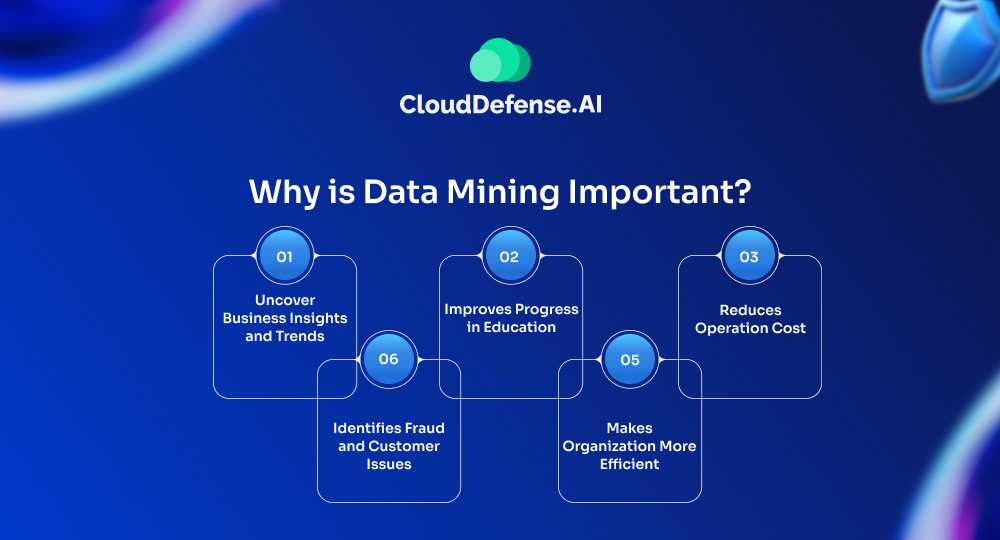
As organizations gather more and more data, data mining has become an important aspect of business analytics strategy. This process helps in extracting useful information that can help the organization decide its next move, improve customer service, find new trends, and identify new sources of revenue.
Here are some primary reasons that make data mining vital for most organizations:
Uncover Business Insights and Trends
One of the primary reasons that make this mining vital is the ability to extract business insights and trends from a pool of huge data sets. These insights help organizations across the industries to make informed decisions.
Identifies Fraud and Customer Issues
Data mining is highly effective in identifying frauds, customer issues, or compliance violations as it provides numerous insights and various patterns. Analysts can analyze those patterns and identify fraudulent transactions.
Improves Progress in Education
This data extraction and aggregating process is highly important in helping educational institutes test students’ education progress, lesson requirements, and areas requiring improvement.
Makes Organization More Efficient
Data mining makes sure an organization is gathering and analyzing relevant sets of data and not unnecessary ones. It is a structured process that gathers data according to the requirements of the organization, helping organizations to be more efficient.
Reduces Operation Cost
Another reason that makes it important for many organizations is its ability to reduce operation costs. It analyzes performance data on various aspects and prevents bottlenecking of different processes and other aspects that are slowing down operations.
Important Data Mining Techniques
When it comes to data mining, it is not restricted to only one technique and organizations can utilize various techniques for different applications. Here are some important techniques used across the industry:
Association Rule Mining
Association rule mining is a widely used technique that assists analysts in finding relationships between two unrelated data sets. This technique is based on an if/then rule-based method where support and confidence criteria are utilized for assessing the relationship.
Support indicates the frequency of related elements occurring in a data set whereas confidence shows the total amount of if-then statements appears accurate.
Classification
It serves as a complex technique where ML algorithms are utilized to assign elements of a data set into different categories. Statistical methodologies like nearest neighbor or decision tree are mostly utilized for recognizing the category.
Usually, the algorithm is programmed with recognized data classification to identify the type of new elements in the data set.
Clustering
Clustering shares some similarities with classification techniques but in these techniques, multiple data points are grouped based on their similarities. Here all the similar items of the data set are grouped on the basis of what makes them different from other items. It involves a larger set of data elements.
Regression
Regression is a popular technique that identifies relationships in data sets by calculating the predicted outcome based on the predetermined variables. The regression technique mostly involves linear and multivariate regression.
Sequence and Path Analysis
This type of technique looks for specific patterns where a set of events leads to another event. This technique is highly effective in recognizing variations that occur at regular intervals.
Decision Tree
Decision tree techniques are utilized to classify or predict the result depending upon the decisions or criteria. It utilizes a tree-like visualization where it showcases potential results depending upon the decisions.
Neural Networks
A neural network technique involves various algorithms that simulate the functioning of the human brain to process data sets through nodes. Here each node is made up of inputs, outputs, and biases. This technique is mostly used in applications for identifying complex patterns.
What are the Applications of Data Mining?
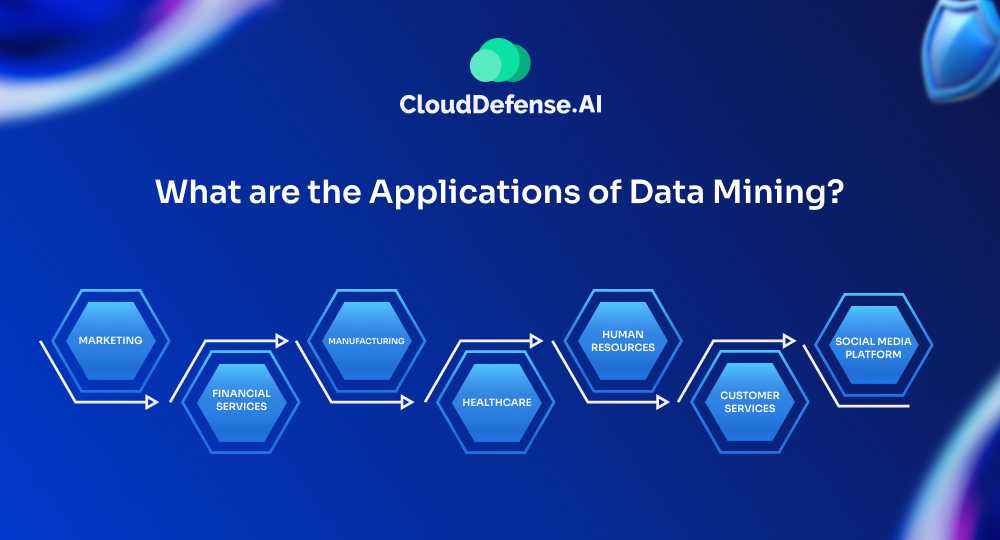
In the modern data-driven industry, almost every organization uses data mining in one way or another as part of their analytics strategy. The popular applications of data mining are:
Marketing
Data mining is widely used in marketing as it lets organizations extract useful patterns and trends that let them understand what their customers need and which product is suitable for which customer group. Modern marketing experts align mining outcomes with their marketing campaigns and offer to produce better results.
Financial Services
A large number of financial services use data mining tools to perform various types of financial services. From identifying fraudulent transactions, upselling opportunities, and verifying credit applications to creating risk models, data mining is widely used for improving different financial services.
Manufacturing
Data mining plays a crucial role in the manufacturing division as it helps them improve operational efficiency, production uptime, and supply chain performance. It enables the team to prevent interruption in manufacturing and understand which materials are used efficiently and what bottlenecks are impacting the process.
Healthcare
This process has also found its application in the healthcare sector where it enables doctors to analyze X-rays, probable health causes from various medical tests, and treat patients more efficiently. It aids doctors in deciding the correct treatment for a medical condition.
Human Resources
The HR department of numerous organizations actively relies on data mining because it provides information regarding employee performance and satisfaction. It analyzes a large set of data related to various factors such as training, work delivery, promotion, and peer performances to make suggestions.
Customer Services
Customer services departments largely benefit from data mining because it provides them with rich customer insight and helps them devise how they should interact with the customer. It highlights the factors that please the customer and areas that lead to dissatisfaction.
Social Media Platform
Almost every social media platform widely uses data mining because it analyzes user data that helps in identifying editorial opportunities or targeted advertising. It is often used to sell user data to large enterprises.
Advantages and Disadvantages of Data Mining
Data mining might offer numerous benefits which makes it a suitable choice for most organizations but it is also not devoid of any disadvantage. Let’s explore all the advantages and disadvantages of data mining:
Advantages of Data Mining
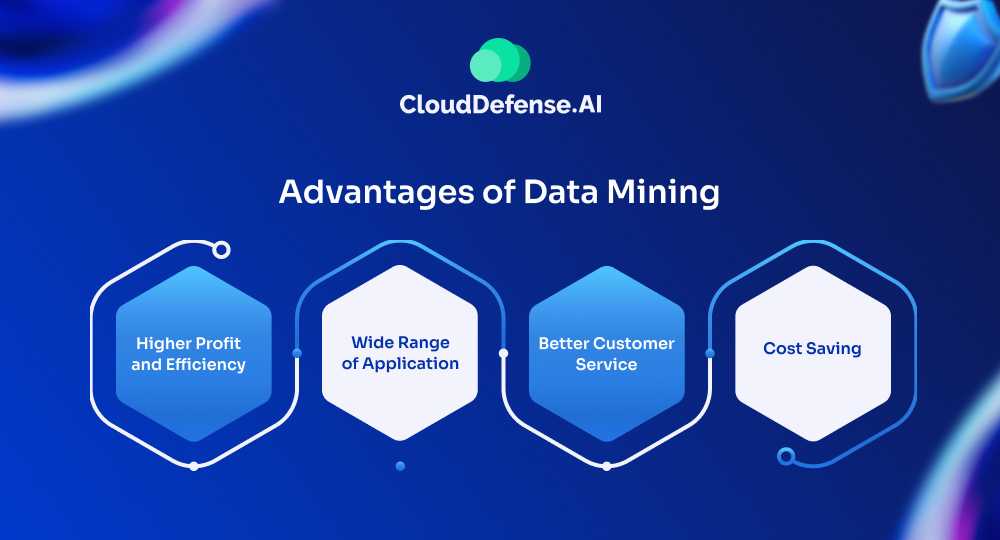
- Higher Profit and Efficiency- Data mining is highly beneficial for an enterprise as it feeds them with the correct set of data which drives numerous decisions and strategies.
This process gathers a lot of data which helps in extracting useful trends for business strategies, identifying problems in the infrastructure, and various important patterns. Thus, it is able to help the organization become highly efficient and more profitable.
- Better Customer Service- Data mining has been instrumental for organizations to offer better customer service by identifying customer issues and customer behavior. The data helps organizations deal with customers more diligently and cater to all their requirements more efficiently.
- Wide Range of Application- Data mining is widely used for different purposes as it can gather and analyze any type of data type. The best part is that every business from across the industry can use data mining to identify problems, extract useful trends, understand areas of improvement, and identify upcoming trends. It can integrate with any legacy or new application to offer better output.
- Cost Saving- A major reason data mining is widely used is because it helps save a lot of cost by improving operational efficiency, and data accuracy, reduces waste in spending, and curbs redundancy.
Disadvantages of Data Mining
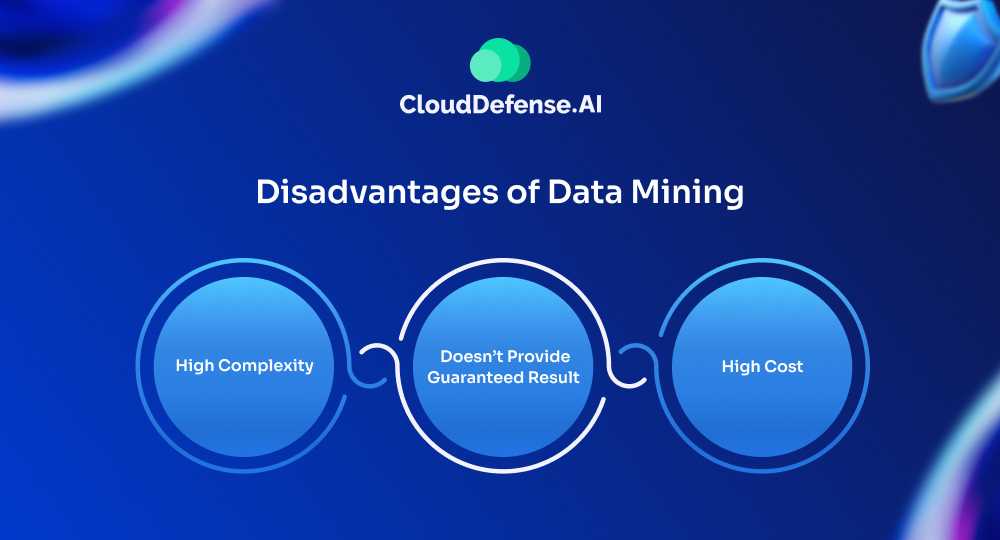
- High Complexity- The high complexity associated with data mining is a major drawback. It requires highly skilled individuals and a specific toolset to efficiently perform the mining process.
- Doesn’t Provide Guaranteed Result- When you implement data mining, it doesn’t mean you will guarantee the result. Various factors like model error, sudden market change, inaccurate findings, and inappropriate data source servers as a possible result of poor output.
- High Cost- Data mining might reduce operation costs but running data mining can be costly. Data mining tools come with a significant subscription cost and there are specific data sets that are expensive to obtain.
Prime Example of Data Mining
Data mining has a wide range of applications and it depends on how organizations are using it. Here are two prime examples of data mining:
eBay
One of the largest e-commerce sites, eBay is widely known for using data mining to understand the relationship between products, analyze purchase patterns, and understand feasible price ranges. eBay also uses the mining process to categorize products and makes it easy for buyers to find the right product.
Facebook-Cambridge Analytica Scandal
Data mining also has a bad side and the Facebook-Cambridge analytic scandal is one example. Cambridge Analytica in 2010, collected millions of Facebook user’s personal data and analyzed it to use for the 2016 American presidential campaign.
It is also suspected Cambridge Analytica also used data mining to interfere with the Brexit referendum. Due to this, Facebook agreed to pay $100 million for illicit usage of user data.
Final Words
In today’s data drive industry, data mining has helped organizations in many ways. Not only have they improved performance and operational efficiency but also have helped enterprises get an edge over their competitors.
By gathering information regarding their customer, operations, manufacturing, employees, and products, organizations are able to devise a data-driven strategy that helps them steer forward.







